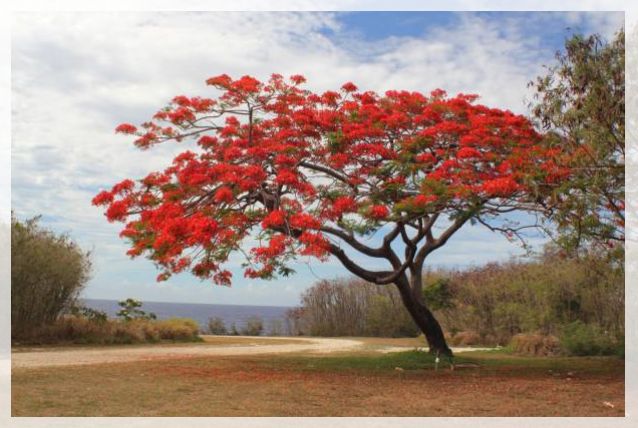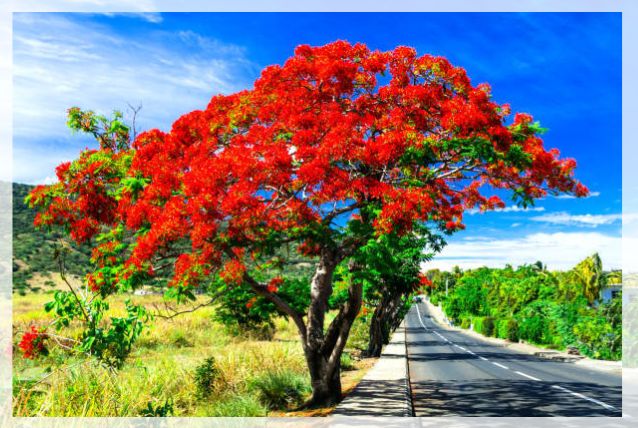Do you know that Delonix Regia or Flamboyant is a tropical tree that is famous for its broad-spreading, umbrella-like canopy of lacy, feathery green leaves cut into a number of leaflets?
This tree is an evergreen tree, except in climates that have dry seasons or mildly cold winters.
Moreover, it is popular for its floral display.
In late spring to early summer, it tends to be covered with a profusion of brilliant scarlet orange flowers, up to 4 inches, adorned with yellow or white markings.
Borne in large clusters near the tips of the branches, the blossoms of this tree give away flattened, mahogany bean-like seedpods.
These are 24 inches long that tend to hang on the branches.
These pods split open when fully mature to release a number of seeds.
Keep on reading.
Delonix Regia
The flame tree also known as Royal Poinciana, Delix Regia is a fast-growing evergreen tree.
It features an abundance of crimson blossoms.
This African native tends to be a favorite in a number of topical and subtropical locations.
However, it will need a large space away from buildings to accommodate its expansive root system.
Moreover, the foliage of this species is a bipinnately compound.
This means that each leaf consists of up to 25 pairs of leaflets and each of these leaflets is further divided into up to 25 more pairs of leaflets.

This tree is popular and renowned around the world for its clusters of exquisite red flowers.
These flowers blanket the tree in the warm summer months.
Furthermore, each of the 5 petals is reddish-orange or scarlet.
One petal is bigger than the others and has yellow and white markings.
The fruit is a seed pod that is over a foot long.
Learn more about Koi Pond: How to Build One here.
Quick Facts about Flame Tree
Some quick facts about Delonix regia are:
| Common Name | Royal poinciana, flame tree, flamboyant, peacock flower, gold mohair, royal flame tree |
| Botanical Name | Delonix regia |
| Family | Fabaceae |
| Plant Type | Tree |
| Mature Size | 30–40 ft. tall, 40-70 ft. wide |
| Sun Exposure | Full |
| Soil Type | Loamy, sandy, clay, well-drained |
| Soil pH | Acidic, neutral, alkaline |
| Bloom Time | Summer |
| Flower Color | Red, orange |
| Hardiness Zones | 10–12 (USDA) |
| Native Area | Africa |
Delonix Regia Care
You will need to plant the flame tree, Delonix Regia in a spot where it has enough space to grow.
Not only this variety of trees can reach up to 40 feet in height, but, it can also spread between 40 and 70 feet wide.
Moreover, it can be damaging if you do not plant this tree in the proper area.
Thus keep the plant away from walls, pavement, or anything else it may overtake.
After planting the tree, cover the soil under the tree, leaving some space near the truck, with a 2-inch layer of mulch.
Light: A flame tree can grow in a number of soil conditions as long as there is good drainage.
The tree can tolerate clay, loamy, sandy, or gravelly soil in a wide range of pH between 4.9 and 10.6.
Water: After planting, make sure to water your tree regularly during the spring, summer, and early fall.
Keep the soil moist, but never soggy, until the roots become established.
Moreover, make sure that the soil dries out between watering.

During the late fall months, you will need to gradually cut down on the water supply before stopping extra watering during the winter months when the tree goes dormant.
Temperature and Humidity: As the tree is native to tropical forests, it will do well in warm, humid environments.
Moreover, this tree can tolerate temperatures below 45 degrees Fahrenheit.
You can easily grow in parts of Florida, Texas, and Hawaii, for instance.
It is only suitable for reliably warm climates.
Fertilizer: You will need to give your tree a balanced liquid fertilizer for four to six weeks after planting.
And then 2 to 3 times per year for the first three years.
Make sure to give an additional application of fertilizer in early spring and fall.
For the amount to use, always make sure to follow the product label instructions.
Water the tree thoroughly after you have fertilized the soil.
Types of Delonix
Some other flowering trees in the Delonix genus are:
Delonix elata (White gul mohur, creamy peacock flower)
This one has smaller white flowers than D. regia.
Its flowers are white and tend to fade to yellow, and the tree reaches 30 ft, in height and is very drought-tolerant.
D. floribunda (Yellow poinciana)
This one tends to be a small to medium size tree, a drought-tolerant tree with greenish-white flowers.
Moreover, it tends to have a thick and swollen trunk.
It is suitable to be grown as a potted tree outdoors and you can also choose to train it as a bonsai.
Learn more about How to Create a Gravel Garden? here.
Pruning and Propagating Tips
You will need to prune the flame tree to create a strong tree structure, as the limbs of this tree are susceptible to breakage in high winds.
Around late March or early April, or right before spring growth begins in your area, make sure to prune any major branches that are half the diameter of the truck or below 8 to 12 feet from the ground.
You can propagate this tree through seed germination and cuttings.

To propagate from seed cuttings, follow the steps below:
- with the help of a sharp knife, take a cutting about one foot long
- make sure to remove any leaves from the lower third of the stem
- dip the stem in the rooting hormone
- plant the cutting in a 1-gallon container filled with damp potting mix
- place the pot in a warm outdoor location, but away from direct sunlight
- make sure to keep the soil evenly moist until you see new growth
- this can take a number of months
- once it begins to grow, you can move it to a sunny location but let it grow into a strong sapling before placing it in the landscape
Growing from Seeds
You can germinate the seeds and plant the seedlings at any time.
However, the seeds will need to be scarified first to break open the seed coat and allow water to germinate the seed.
If you already have a flame tree in your garden, you can harvest the long, strappy dark brown seed pods when they fall to the ground in spring.
Follow the steps:
- remove the seeds from the pod
- by soaking the seed in warm water, softening the coating of the seeds for a day or two before planting in potting mic
- scarify the softened seeds by gently nicking or scratching each one with the help of a knife
- this will allow water in and speed up the germination process
- some gardeners suggest that you can rub the seed with sandpaper for a few seconds to generate peeling
- add well-draining potting mix to a 3 to 6-inch deep sand tray
- place each seed at least 1-inch deep and 3 inches apart
- pat the soil firmly around each seed
- put the tray in a warm, partially shaded outdoor spot
- keep the soil moist but not overwatered
- seeds will begin to germinate in 4 to 6 days
- you can then transplant 8-inch high seedlings to a 1-gallon container
- continue transplanting your seedlings as they grow until you are ready to select a spot in your landscape to root the tree
Growing in Pots and Overwintering
It is important to note that you cannot grow the flame tree in a pot due to its large size.
However, you can choose to grow it and train the tree as a bonsai.
As such, it will need potting every two years.
Moreover, the flame tree cannot tolerate frost as it will rot the roots.
Thus, if there is ever the danger of frost in the typically no-frost zones of 10 to 12 USDA, you will need to cover the smaller tree with burlap or a tarp overnight.
Common Pests and Plant Diseases
Though flame trees do not have a number of pests, some species of caterpillars can chew away the leaves.
However, it will not defoliate the entire tree.
Moreover, spider mites can be an issue, especially if the tree is not in a humid environment.
If you spot them, you will need to increase the humidity or set your plant outdoors.
Also, scale insects can be an issue and they will appear under the leaves.
You can choose to remove them with cotton swabs dipped in alcohol.
Phellinus noxious is a fungus that can cause the roots of a tree to rot.
Thus, choose a pot with soil that drains well as it will help reduce the possibility of this fungus invasion.
Can you get the Tree to Bloom?
It is important to note that if your tree is not blooming, it may not be mature enough.
It can take about 6 to 10 years for the tree to bloom for the first time.

Another reason for its failure to bloom can in the insufficient sun.
Thus, make sure that your tree gets full sun in order to bloom.
Common Problems
Litter can occur if the branches that are brittle break or when the seeds pods tend to fall to the ground.
You can choose to reduce the chances of breaking branches if you can provide a spot with protection from winds and prune to form a strong branching structure.
Moreover, the tree tends to have a shallow root system.
This will not only compete with the neighboring plants for space but also make the tree prone to being uprooted in strong winds.






Leave a Reply